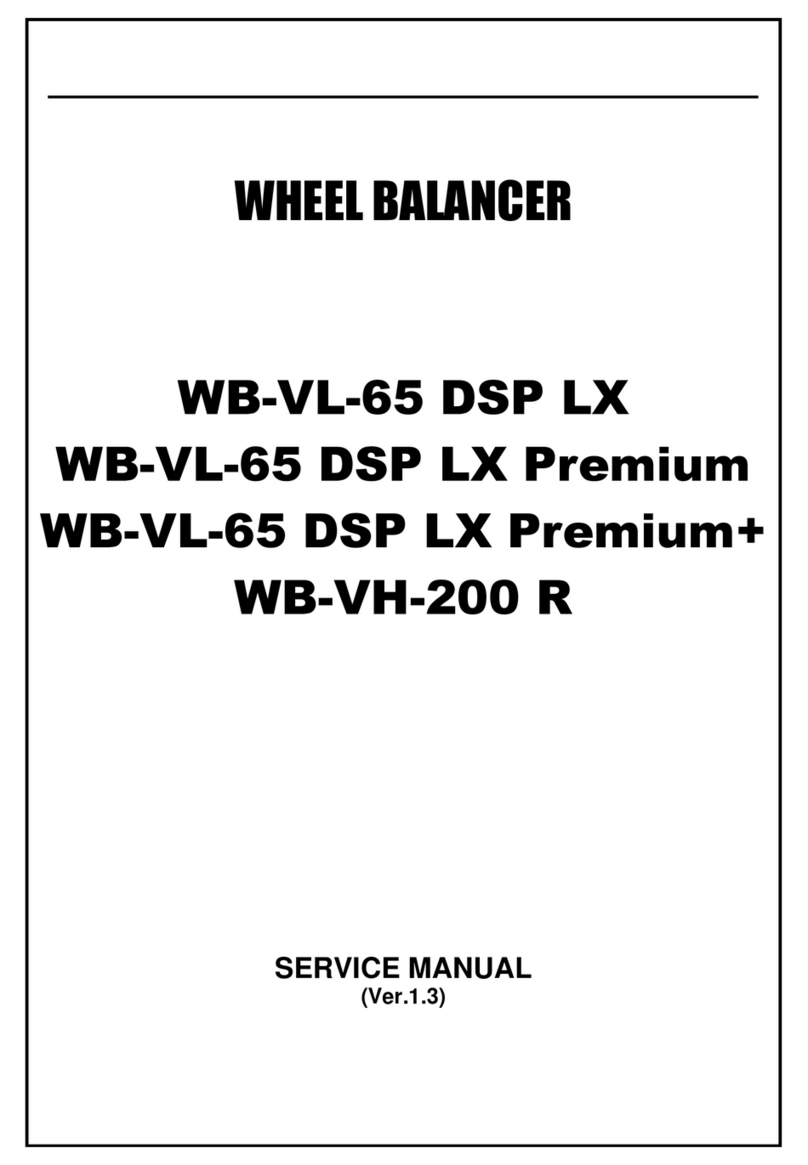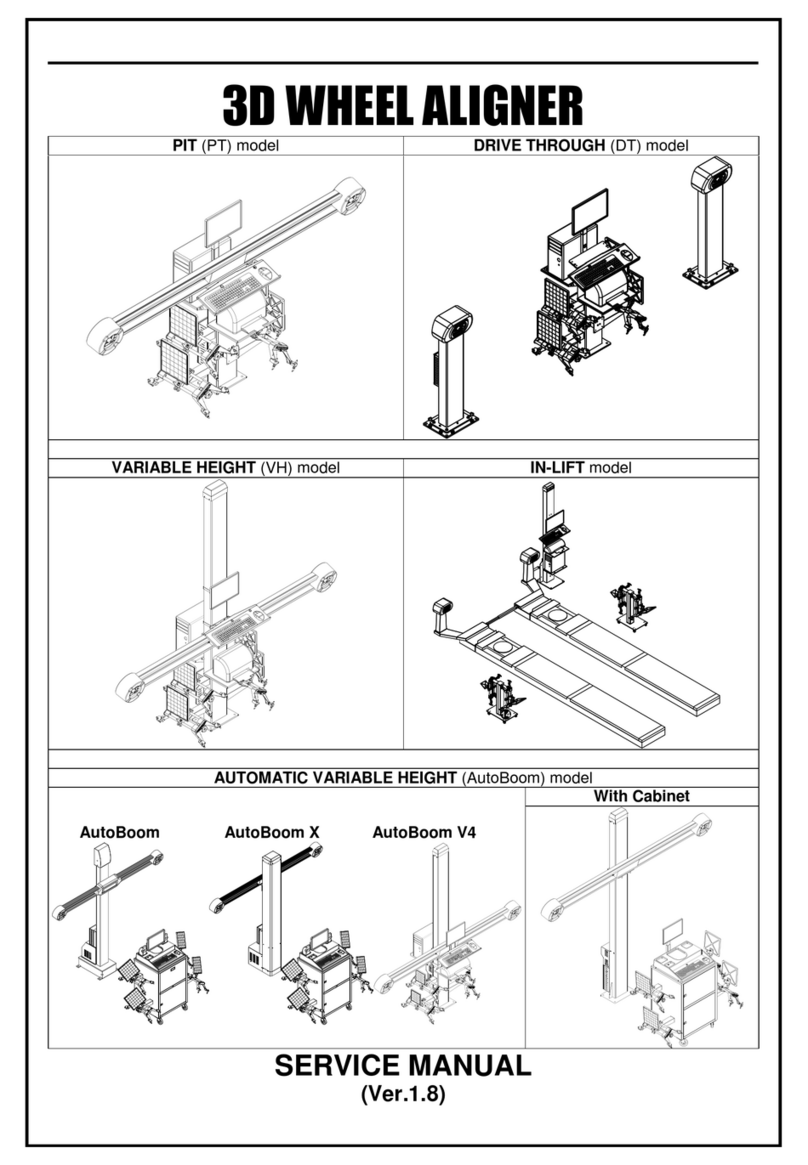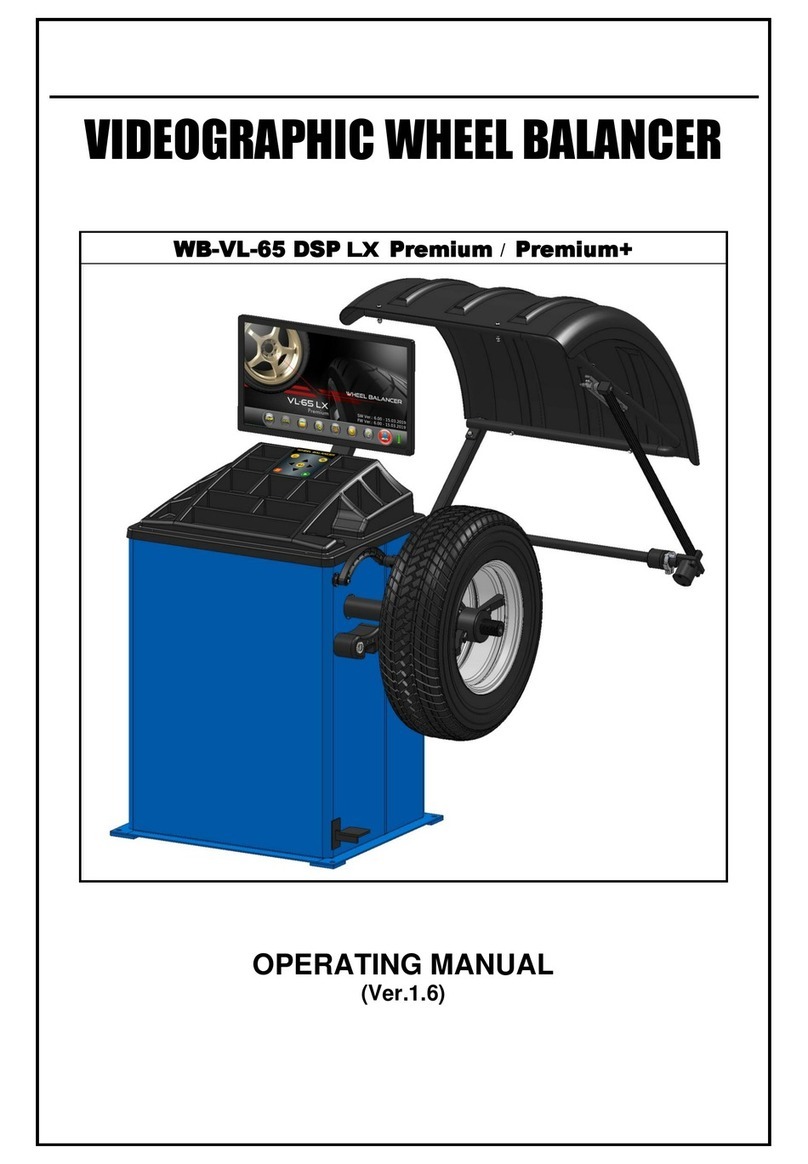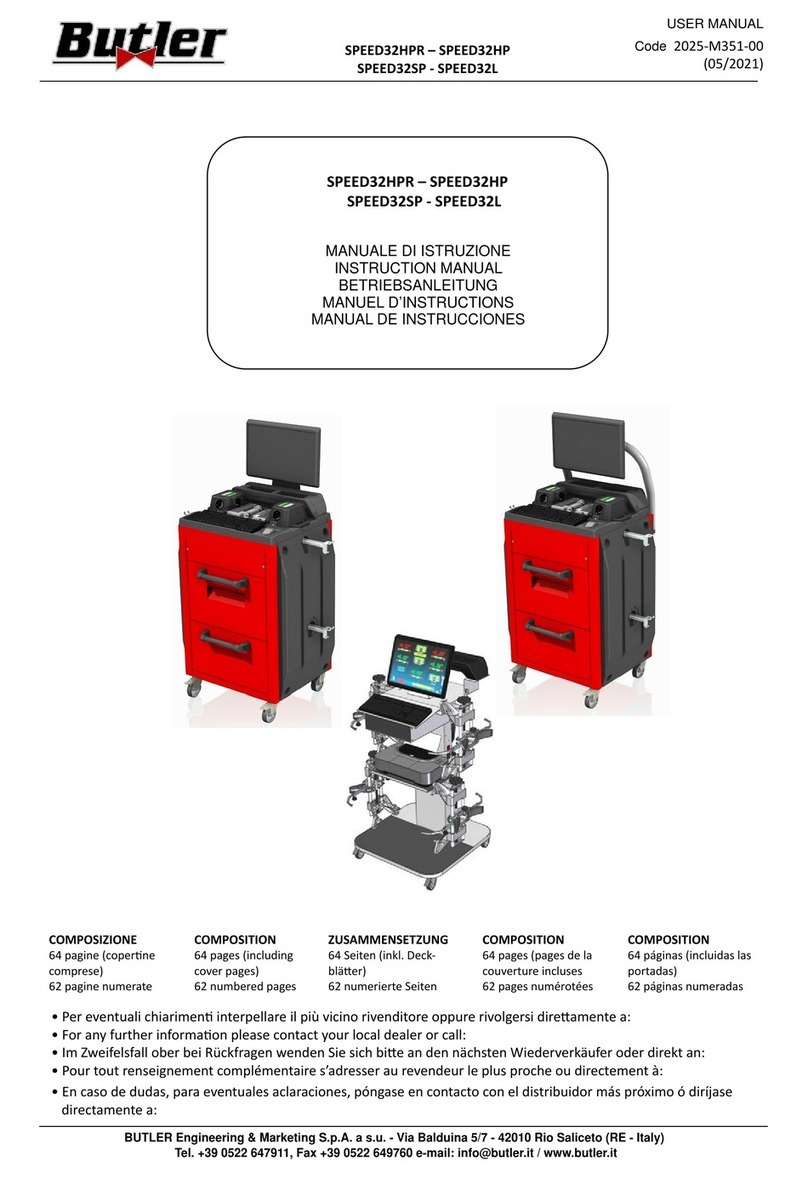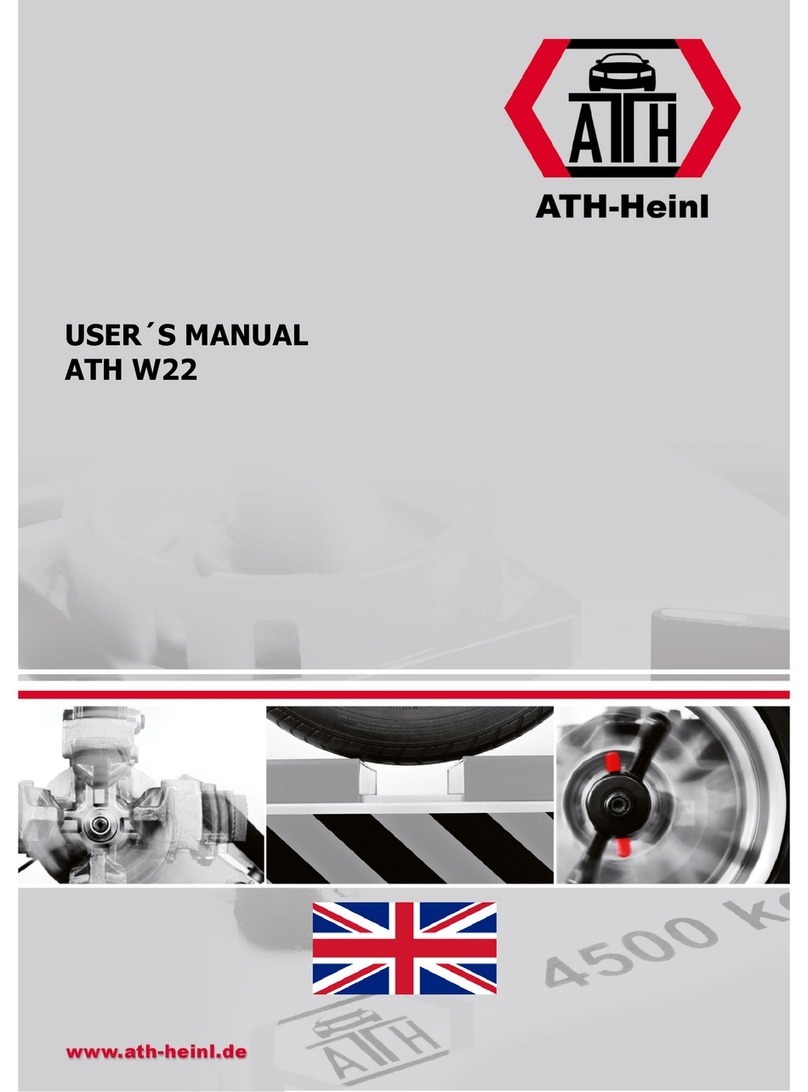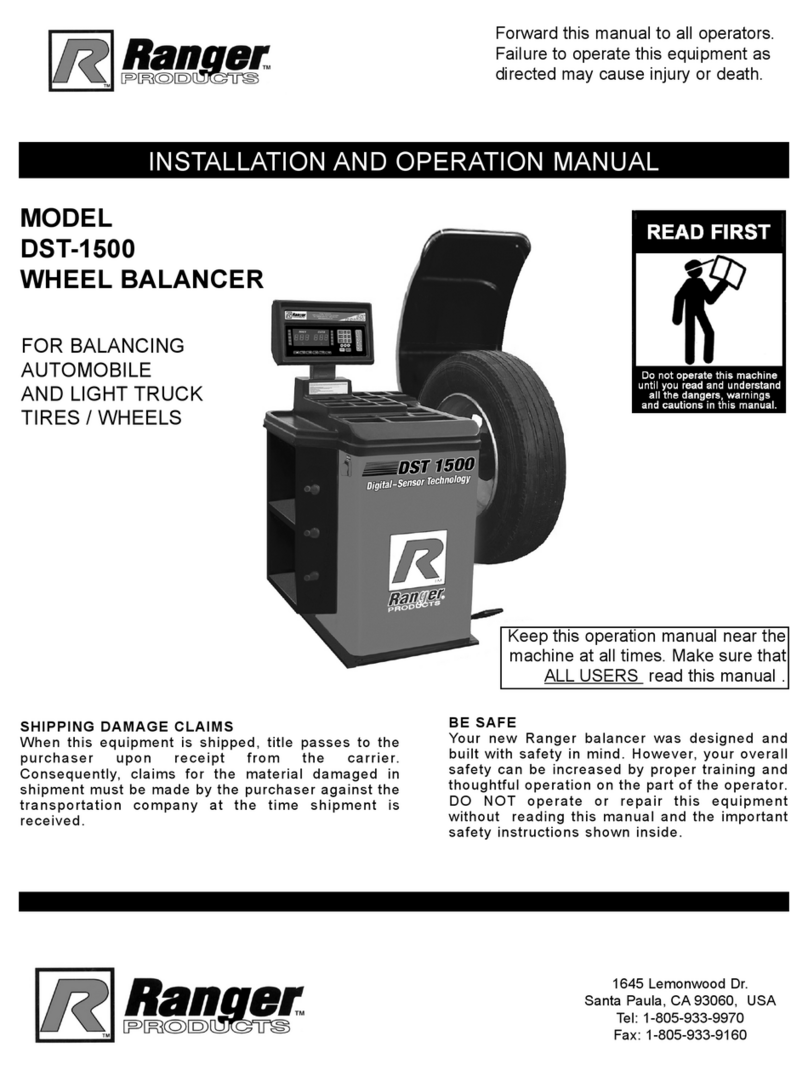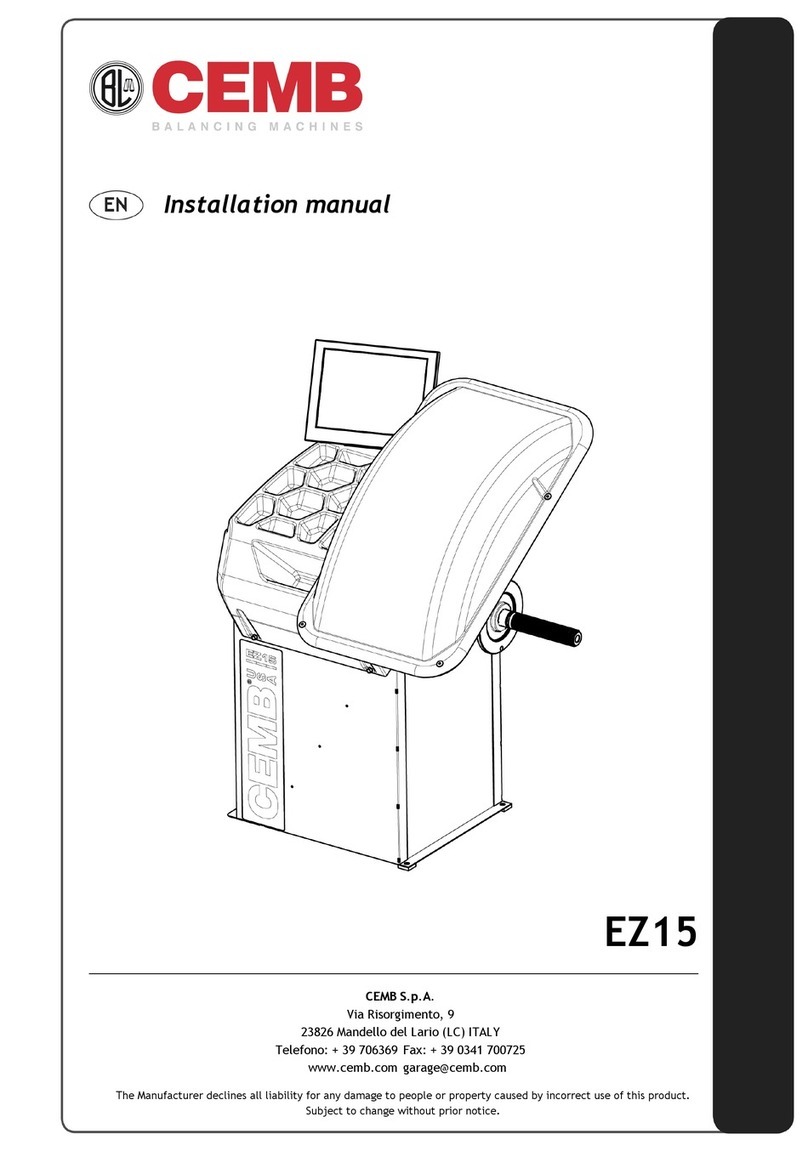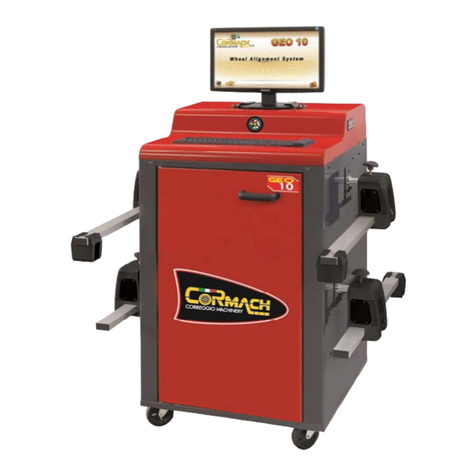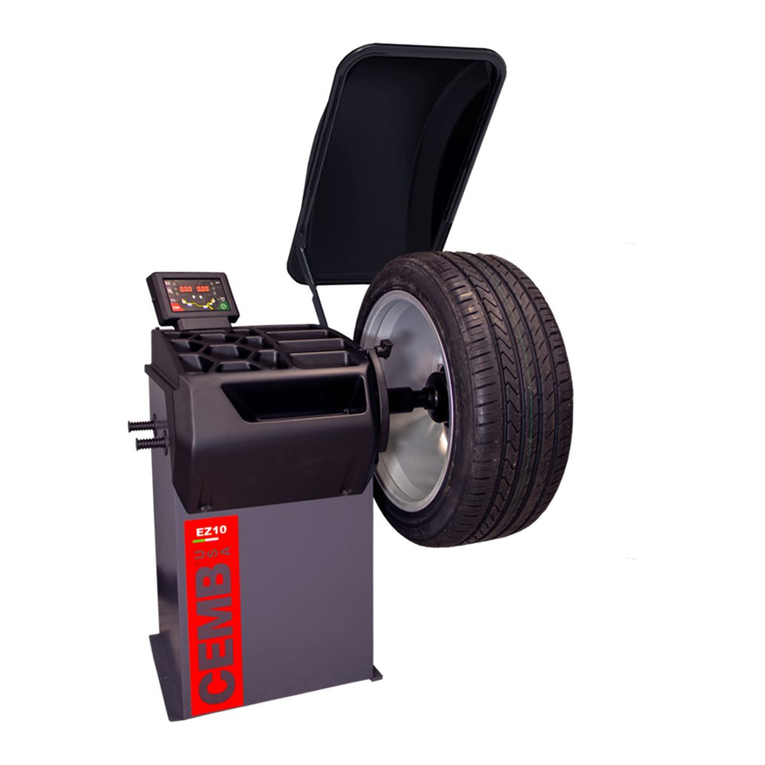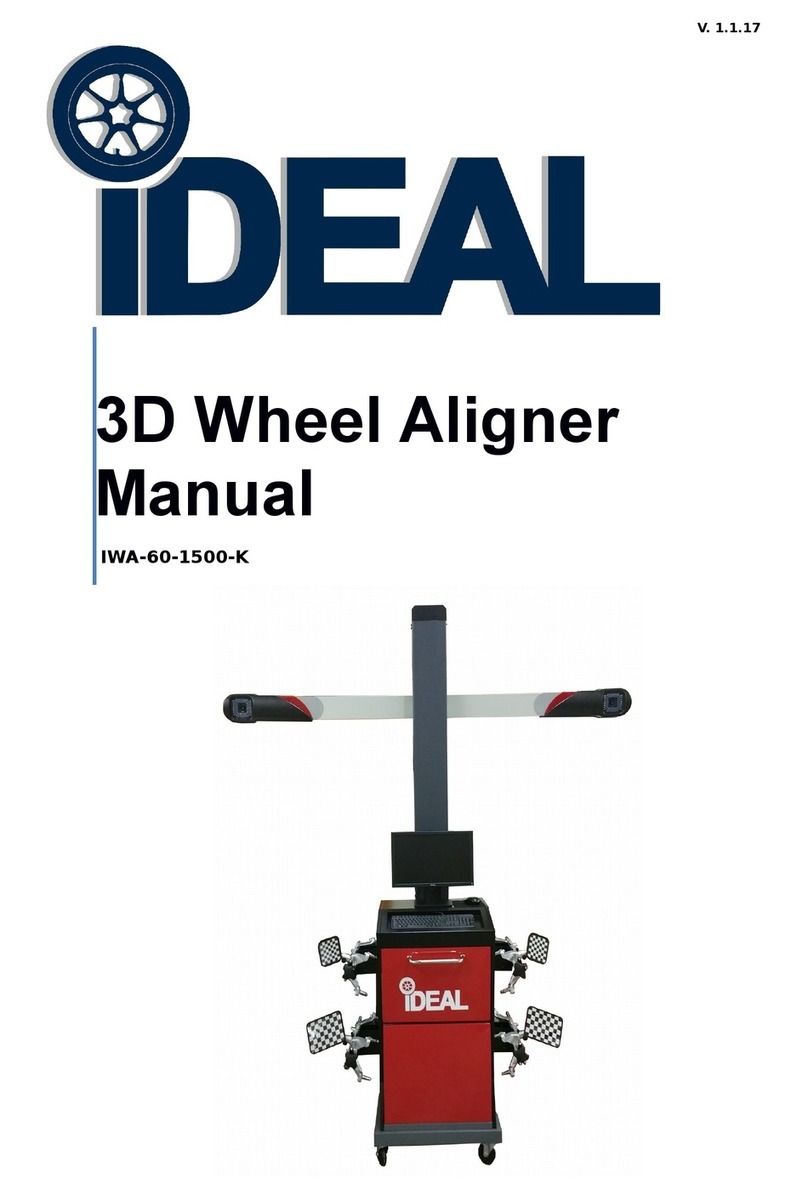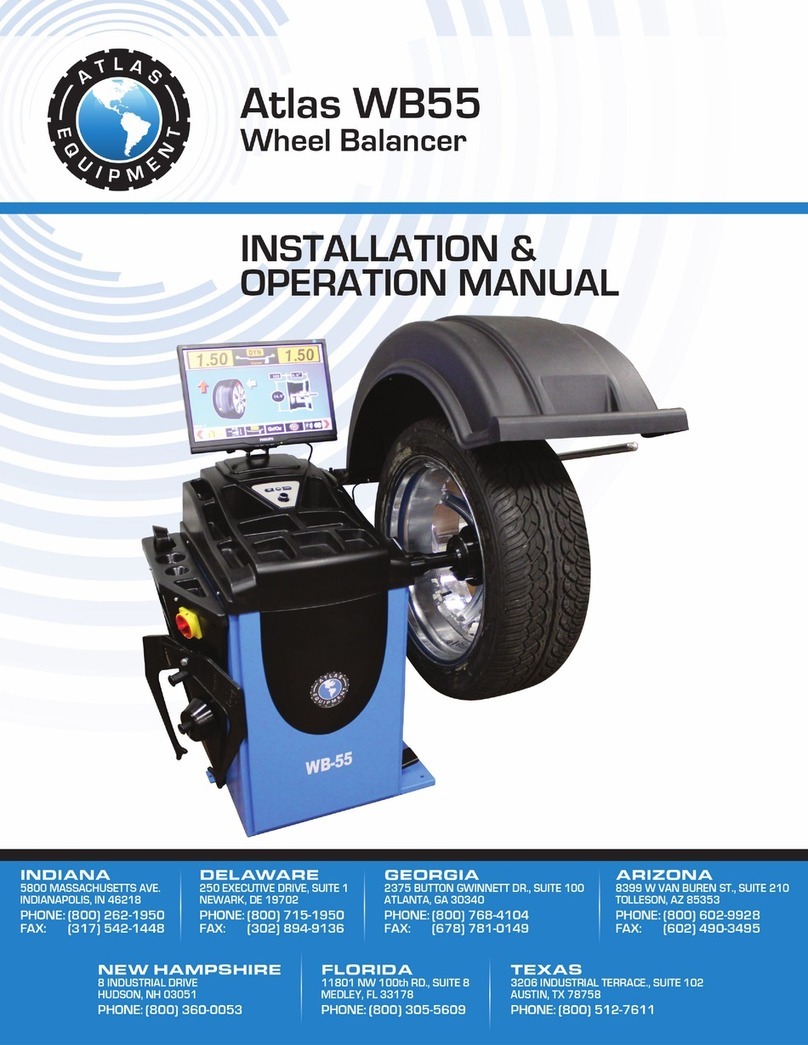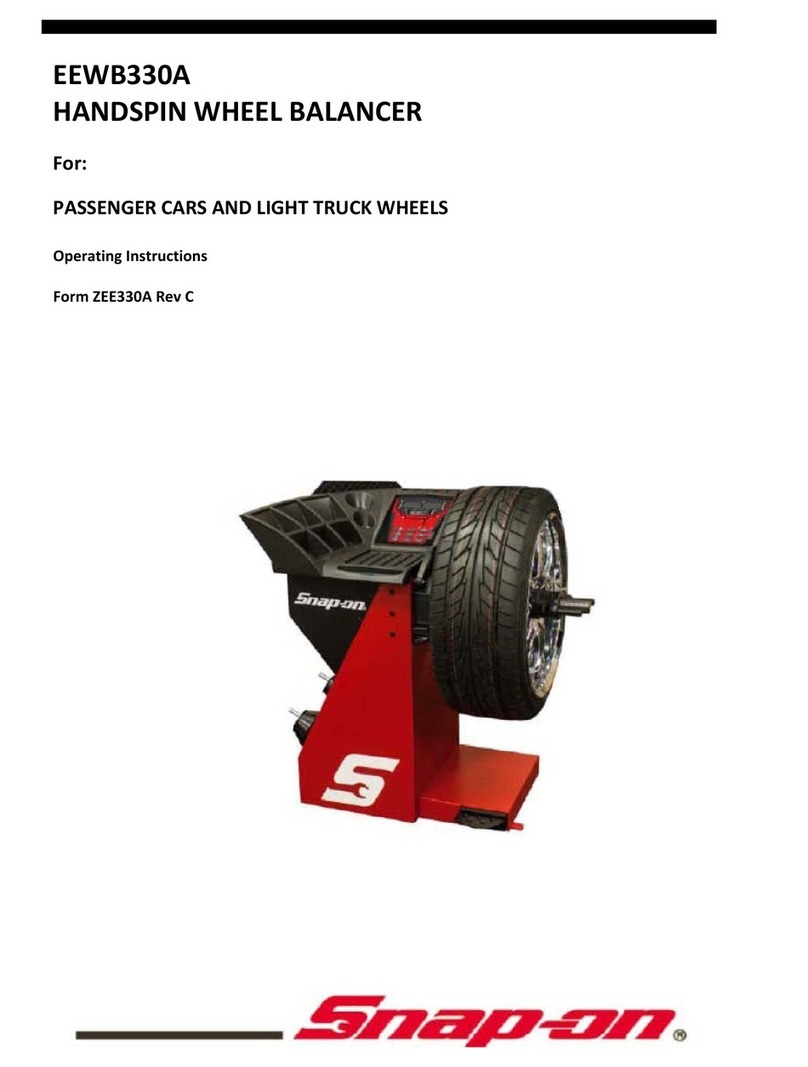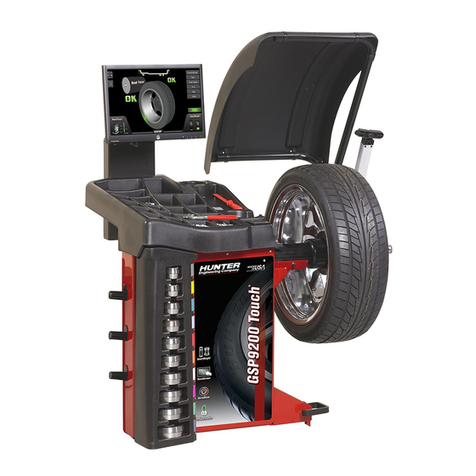MANATEC JUMBO HCV User manual

3D WHEEL ALIGNER
HCV model
OPERATING MANUAL
(Ver.1.7)

Dear Customer,
Congratulations, for selecting 3D Wheel aligner as your Wheel alignment computer. Our Wheel
aligners are user friendly system which can be used effectively to correct all the alignment angles
of four wheelers.
We take special care to ensure that every Wheel aligner leaving our Factory is in the best
operating condition. This OPERATING MANUAL has been prepared to help you in getting the
best performance out of the equipment. Still, if you have any doubt, please do not hesitate to
contact us.
Read the Operating manual carefully before starting to use the equipment
Every attempt is made in this manual to guide the User on the effective use of the
Equipment. Any suggestion may please be sent to us for improvement.

INDEX Page No.
1. WARRANTY –STATUTORY CLAUSE 1
2. SAFETY 2
2.1. INTENDED USE 2
2.2. SAFETY INSTRUCTIONS FOR COMMISSIONING 2
2.3. SAFETY INSTRUCTIONS FOR OPERATION 3
2.4. SAFETY INSTRUCTIONS FOR SERVICING 3
2.5. SAFETY FEATURES 4
2.5.1. POWER FAILURE DATA RECOVERY 4
2.5.2. CONTROL FUSES 4
2.5.3. HIGH VOLTAGE PROTECTION 4
2.6. SAFETY LABEL INFORMATION 4
3. FEATURES & SPECIFICATIONS 5
4. INSTALLATION 8
4.1. INSTALLATION REQUIREMENTS 8
4.2. LOCATION 8
4.3. SPACE REQUIREMENTS 8
4.3.1. ALIGNMENT PIT DIMENSIONS (Minimum 13 mtrs / maximum 18 mrts) 8
4.4. POWER REQUIREMENT 11
5. WHEEL ALIGNMENT PARAMETERS 12
5.1. CAMBER 12
5.2. TOE 14
5.3. CASTER 15
5.4. KINGPIN INCLINATION (Steering axis inclination) 16
5.5. THRUST ANGLE 17
5.6. SCRUB ANGLE (HCV) 18
5.7. PARALLELISM (HCV) 18
5.8. FRONT WHEEL SETBACK 19
5.9. REAR WHEEL SETBACK 20
5.10. WHEEL RUNOUT 21
5.11. INCLUDED ANGLE 22
5.12. TRACK WIDTH DIFFERENCE 23
5.13. LOCK ANGLE 24
5.14. TOE OUT ON TURNS 25
6. DESCRIPTION OF MAIN PARTS 26
6.1. VERTICAL COLUMN (Left & Right) 27
6.2. INTERFACE BOX 27
6.3. TARGET PLATE 28
6.4. MAIN CABINET (refer scope of supply) 28
6.5. DESKTOP COMPUTER (refer scope of supply) 28
6.6. DISPLAY UNIT –Primary & Secondary (refer scope of supply) 31
6.7. KEYBOARD (refer scope of supply) 31
6.8. MOUSE (refer scope of supply) 31
6.9. STANDARD ACCESSORIES (refer scope of supply) 32
6.9.1. WHEEL BRACKET (HCV) –12” to 24” 32
6.9.2. ROTARY PLATE (7 ton) 33
6.9.3. ROTARY PLATE SEGMENT PLATE 33
6.9.4. FRONT TARGET PLAT EXTENSION SPACER, 150mm Lg. 33
6.9.5. WHEEL STOPPER 33
6.9.6. LCV STEERING LOCK 34
6.9.7. HCV STEERING LOCK 34
6.9.8. LCV BRAKE PEDAL LOCK 34
6.9.9. HCV BRAKE PEDAL LOCK 34
6.9.10. WHEEL BRACKET HOLDING POST, 3 HOLDER 35
6.9.11. WHEEL BRACKET HOLDING POST, 2 HOLDER 35
6.9.12. ROTARY PLATE PIT SPACERS 35
6.9.13. RATCHET WITH CHAIN BLOCK 36
6.9.14. PLASTIC TOOL BOX & ORGANIZER 36
6.9.15. DATA MANAGER SOFTWARE 36
6.10. OPTIONAL ACCESSORIES (Refer scope of supply) 36
6.10.1. WHEEL BRACKET (HCV) –15” to 28” 36
6.10.2. WHEEL BRACKET EXTENSION ADAPTER 36
6.10.3. RIM LOCKING PIN –Double sided (for Steel cast rims) 36
6.10.4. RIM LOCKING PIN –Double sided (for Low contour steel rims) 36
6.10.5. RIM LOCKING PIN –Double sided (for Run flat tyre rims & Fancy disc) 37
6.10.6. RIM LOCKING PIN –Double sided (for Standard & Steel rims) 37
6.10.7. TYRE CATCHING 3POINT CLAMP 37
6.10.8. LONGER SLIDER 37
6.10.9. AXLE OFFSET GAUGE 37
6.10.10. TYRE DIA GAUGE 37
6.10.11. FRAME REFERENCE GAUGE FOR TRUCKS & BUSES 38
6.10.12. DRAWBAR (TOW BAR) GAUGE FOR FULL TRAILER 38
6.10.13. FOUR SHAFT CALIBRATION KIT WITH 300mm SPACER 38
6.10.14. HCV ROTARY PLATE, SLIM TYPE 39
6.10.15. HCV ROTARY PLATE RAMPS 39
6.10.16. WINCH (5443kg) 39
6.10.17. EARTHING ROD 40
6.10.18. PRINTER 40
6.10.19. MULTIMEDIA SPEAKER 40
6.10.20. INTERNATIONAL VEHICLE DATA (refer scope of supply) 40

7. OPERATION 41
7.1. DEFECTS / MALFUNCTIONS 41
7.2. PRELIMINARY ALIGNMENT PREPARATION 41
7.3. MAIN MENU 47
7.4. ALIGNMENT 48
7.4.1. VEHICLE SELECTION 49
7.4.2. WHEEL RUNOUT 51
7.4.2.1. CUSTOMER DATA INPUT 53
7.4.3. CASTER & KINGPIN SWING 56
7.4.3.1. TURN LEFT 56
7.4.3.2. TURN RIGHT 57
7.4.3.3. STRAIGHT AHEAD 57
7.4.4. ALIGNMENT PARAMETERS & RESULTS 59
7.4.4.1. THRUST ANGLE ADJUSTMENT 60
7.4.4.2. REAR WHEEL PARAMETERS 61
7.4.4.3. FRONT WHEEL PARAMETERS 61
7.4.4.4. DIFFERENTIAL TOE ADJUSTMENT 62
7.4.4.5. PARALLELISM ADJUSTMENT 63
7.4.4.6. PUSHER AXLE ADJUSTMENT (Single Tie rod) 64
7.4.4.7. SCRUB ANGLE ADJUSTMENT 65
7.4.4.8. TAG AXLE ADJUSTMENT 66
7.4.4.9. CAM / BUSH / SHIM ADJUSTMENT 66
7.4.5. MULTI-AXLE CONFIGURATIONS & APPLICABLE SEQUENCE (Drive Axle Reference) 71
7.4.5.1. CARs and LCVs (6A/5A/4A) 71
7.4.5.2. HEAVY TRUCK –1 Front Axle & 1 Rear Axle (6A/5A/4A) 71
7.4.5.3. HEAVY TRUCK –1 Front Axle & 2 Rear Axles (6A/5A/4A) 71
7.4.5.4. HEAVY TRUCK –1 Front Axle & 3 Rear Axles (6A/5A/4A) 72
7.4.5.5. HEAVY TRUCK –2 Front Axles & 1 Rear Axle (6A/5A/4A) 72
7.4.5.6. HEAVY TRUCK –2 Front Axles & 2 Rear Axles (6A/5A/4A) 72
7.4.5.7. HEAVY TRUCK –2 Front Axles & 3 Rear Axles (6A/5A) 73
7.4.5.8. HEAVY TRUCK –1 Front & 3 Rear Axles (including 1 Pusher 3rd Axle) (6A/5A/4A) 73
7.4.5.9. HEAVY TRUCK –1 Front Axle & 3 Rear Axles (including 1 Tag 1st Axle) (6A/5A/4A) 73
7.4.5.10. HEAVY TRUCK –2 Front & 3 Rear Axles (including 1 Pusher 3rd Axle) (6A/5A) 74
7.4.5.11. HEAVY TRUCK –2 Front Axles & 3 Rear Axles (including 1 Tag 1st Axle) (6A/5A) 74
7.4.5.12. HEAVY TRUCK –2 Front & 4 Rear Axles (including 1 Pusher & 1 Tag Axle) (6A) 75
7.4.5.13. BUS –1 Front Axle & 1 Rear Axle (6A/5A/4A) 75
7.4.5.14. BUS –1 Front Axle & 2 Rear Axles (including 1 Pusher Axle) (6A/5A/4A) 75
7.4.5.15. BUS –1 Front Axle & 2 Rear Axles (including 1 Tag Axle) (6A/5A/4A) 76
7.4.5.16. BUS –1 Front Axle & 2 Rear Axles (including 1 Rear Steering Tag Axle) (6A/5A/4A) 76
7.4.5.17. BUS –2 Front Axles & 1 Rear Axle (6A/5A/4A) 76
7.4.5.18. BUS –2 Front Axles & 2 Rear Axles (including 1 Pusher Axle) (6A/5A/4A) 77
7.4.5.19. BUS –2 Front Axles & 2 Rear Axles (including 1 Tag Axle) (6A/5A/4A) 77
7.4.5.20. TRAILER (Forward parking) –1 Rear Axle (6A/5A/4A) 77
7.4.5.21. TRAILER (Forward parking) –2 Rear Axles (6A/5A/4A) 78
7.4.5.22. TRAILER (Forward parking) –3 Rear Axles (6A/5A/4A) 78
7.4.5.23. TRAILER (Forward parking) –4 Rear Axles (6A/5A/4A) 78
7.4.5.24. TRAILER (Forward parking) –5 Rear Axles (6A/5A/4A) 79
7.4.5.25. TRAILER (Reverse parking) –1 Rear Axle (6A/5A/4A) 80
7.4.5.26. TRAILER (Reverse parking) –2 Rear Axles (6A/5A/4A) 80
7.4.5.27. TRAILER (Reverse parking) –3 Rear Axles (6A/5A/4A) 80
7.4.5.28. TRAILER (Reverse parking) –4 Rear Axles (6A/5A/4A) 81
7.4.5.29. TRAILER (Reverse parking) –5 Rear Axles (6A/5A/4A) 81
7.4.5.30. TRAILER (Reverse parking) –6 Rear Axles (6A/5A/4A) 82
7.4.5.31. TRAILER (Reverse parking) –7 Rear Axles 83
7.4.5.32. TRAILER (Reverse parking) –8 Rear Axles 84
7.4.5.33. FULL TRAILER (Forward parking) –1 Front Axle & 1 Rear Axle (6A/5A/4A) 85
7.4.5.34. FULL TRAILER (Forward parking) –1 Front Axle & 2 Rear Axles (6A/5A/4A) 85
7.4.5.35. FULL TRAILER (Foward parking) –1 Front Axle & 3 Rear Axles (6A/5A) 86
7.4.5.36. FULL TRAILER (Forward parking) –2 Front Axles & 1 Rear Axle (6A/5A/4A) 87
7.4.5.37. FULL TRAILER (Forward parking) –2 Front Axles & 2 Rear Axles (6A/5A) 87
7.4.5.38. FULL TRAILER (Forward parking) –2 Front Axles & 3 Rear Axles (6A) 88
7.4.5.39. FULL TRAILER (Reverse parking) –1 Front Axle & 1 Rear Axle (6A/5A/4A) 89
7.4.5.40. FULL TRAILER (Reverse parking) –1 Front Axle & 2 Rear Axles (6A/5A/4A) 89
7.4.5.41. FULL TRAILER (Reverse parking) –1 Front Axle & 3 Rear Axles (6A/5A) 90
7.4.5.42. FULL TRAILER (Reverse parking) –2 Front Axles & 1 Rear Axle (6A/5A/4A) 91
7.4.5.43. FULL TRAILER (Reverse parking) –2 Front Axles & 2 Rear Axles (6A/5A) 91
7.4.5.44. FULL TRAILER (Reverse parking) –2 Front Axles & 3 Rear Axles 92
7.4.5.45. FULL TRAILER FORWARD PARKING ALIGNMENT PROCEDURE (6A Model) 93
7.4.5.46. FULL TRAILER REVERSE PARKING ALIGNMENT PROCEDURE 99
7.4.5.47. ARTICULATED BUS –1 Front Axle & 2 Rear Axles 105
7.4.5.48. ARTICULATED BUS –1 Front Axle & 3 Rear Axles 106
7.4.5.49. ARTICULATED BUS –1 Front Axle & 4 Rear Axles 107
7.5. DATA MANAGER 109
7.5.1. DATE BASED ALIGNMENT REPORT 109
7.5.2. REGISTRATION NUMBER BASED ALIGNMENT REPORT 110
7.5.3. YEAR BASED ALIGNMENT REPORT 111
7.5.4. TECHNICIAN BASED ALIGNMENT REPORT 112
7.5.5. CUSTOMER DATABASE 113
7.5.6. REMINDER TO CUSTOMER 113

7.6. SETTINGS 115
7.6.1. VEHICLE SPECIFICATIONS 115
7.6.1.1. INTERNATIONAL HCV DATA 115
7.6.1.2. INDIAN HCV DATA 116
7.6.1.3. UNITED STATES HCV DATA 116
7.6.1.4. INDIAN LCV DATA 116
7.6.1.5. USER DEFINED VEHICLE DATA 116
7.6.2. MEASUREMENT UNITS 118
7.6.3. ALIGNMENT DATA 118
7.6.4. WORKSHOP INFORMATION 118
7.6.5. CALIBRATION HISTORY 119
7.6.6. MULTI-USER 119
7.6.7. BACKUP & RESTORE FACTORY CALIBRATION 119
7.6.7.1. BACKUP CALIB DATA FROM PC TO OTHER LOCATION 120
7.6.7.2. RESTORE CALIB DATA FROM OTHER LOCATION TO PC 120
7.6.7.3. BACKUP USER DATA FROM PC TO OTHER LOCATION 120
7.6.7.4. RESTORE USER DATA FROM OTHER LOCATION TO PC 120
7.6.8. RESET JOB NUMBER 121
7.6.9. SETTINGS PASSWORD 121
7.6.9.1. LOCK DETAILS 121
7.6.9.2. RESET PASSWORD 122
7.7. LANGUAGE SETTINGS 123
8. MAINTENANCE 124
9. TROUBLE SHOOTING 125
9.1. ALIGNMENT LCV 125
9.2. ALIGNMENT HCV 127
9.3. DESKTOP COMPUTER & PERIPHERALS 129

Ref.: MEL-WA(3D HCV) - OM Ver.1.7 1
1. WARRANTY –STATUTORY CLAUSE
Equipment is provided with one year Warranty from the date of installation or thirteen months
from the date of dispatch which ever is earlier (International warranty up to fifteen months from
date of dispatch) against any manufacturing defect. Warranty is subject to following conditions:
1. Ensure that proper power supply with protective Earthing is provided to equipment. Any high
voltage may damage the components, leading to system failure or electrical hazards.
Power supply:
230V operation: Single Phase, 230V AC ± 10%, 50/60 Hz + N + PE (or)
110V operation: Single Phase, 110V AC ± 10%, 60/60 Hz + N + PE
(The Potential difference between N –Neutral & PE –Protective Earth should be below
3V)
Laser printer should be connected in a separate power supply. Machine power socket
should not be used for this purpose. The Laser printers consumes more power.
Warranty ceases if this condition is not satisfied
2. Power supply to the equipment should be connected only through a CVT of 1KVA capacity
and then through an UPS of minimum 1KVA capacity with AVR (Automatic Voltage Regulator)
circuit. The system must be shut down before the UPS power trips OFF (due to limited battery
backup time). Failing to comply may lead to operating system / software corruption.
Warranty ceases if this condition is not satisfied
3. Do not attempt to open or service the equipment under any circumstances. Risk of electric
shock may happen. Only authorized / qualified service personnel should trouble shoot the
equipment.
Warranty ceases if the equipment is opened/tampered or serviced by un-authorised
personnel
4. Warranty ceases if this equipment is used for any purpose other than intended use.
5. The equipment must be installed Indoor away from direct Sunlight or reflected Sunlight
through any object or rain / moist areas.
Warranty ceases if the equipment is exposed to Sunlight, Rain / Water
6. Do not attempt to load any other Application software (Audio, Video etc.) under any
circumstances, other than the alignment program loaded in the Factory.
Warranty ceases if the system is loaded with any other Application software
7. If transportation, lifting, unpacking, installation, assembly, start up, testing, repair and
maintenance have been performed by un-authorised personnel, the manufacturer shall not be
responsible for injury to personnel or damage to objects.
8. DO NOT remove or modify any parts of the equipment as this could compromise the
equipment‟s intended use. For any modifications / repairs consult the Manufacturer.
9. The Vehicle specification data must be entered by End user only. MANUFACTURER IS NOT
RESPONSIBLE FOR ANY INCORRECT OR INCOMPLETE VEHICLE SPECIFICATIONS
ENTERED INTO THE SYSTEM. No claim is entertained for any damage or loss.
10. Follow the Alignment lift manufacturer‟s safety recommendations when lifting a vehicle.
MANUFACTURER IS NOT LIABLE FOR ANY DAMAGES CAUSED due to non-
compliance
11. Make the warranty registration by duly signing the Installation, Commissioning & Training
report.
Manufacturer does not warrant third party products / software added to our Wheel aligner
through our Factory integration system. The below listed Third party products / peripherals /
software are covered under the warranties provided by the respective OEM. Third party
manufacturer‟s warranty may vary from product to product. Consult the respective product
documentation for warranty information:
1. Desktop computer with Monitor
2. Printer
3. Keyboard
4. Mouse
5. Multimedia speakers
6. Operating system software

Ref.: MEL-WA(3D HCV) - OM Ver.1.7 2
2. SAFETY
Thoroughly read all Safety labels and Manual instructions before installing, operating and
maintaining the Wheel aligner. They are provided to remind the operator to exercise extreme
care while performing wheel alignment with this product to prevent personal injury and property
damage. Replace any label unreadable or missing on the Wheel aligner. Refer Part No. given
for each Labels for ordering.
It is the Operator‟s responsibility to have sufficient knowledge on the vehicle to be aligned and
to use proper service methods and perform wheel alignment in an appropriate and acceptable
manner that does not endanger safety of the Operator / others in the work area or the
equipment or vehicle being serviced.
Always keep the Manual in a prominent place for quick reference.
Injury to personnel and damage to property incurred due to non-compliance with these safety
instructions are not covered by the product liability regulations.
SYMBOLS
Failure to comply with instructions could result in personal injury
Failure to comply with instructions could result in property damage
Important information
2.1. INTENDED USE
Use the Aligner as described in this Operating manual only.
Use only the Accessories recommended by the manufacturer.
Carryout alignment by positioning the vehicle to be aligned on the Alignment pit /
Alignment lift only.
2.2. SAFETY INSTRUCTIONS FOR COMMISSIONING
1. Only Authorized service personnel are allowed to install and commission the
Wheel aligner.
2. Aligner should not be installed outdoors or in moist rooms (nearer to car
washing).
3. To reduce the risk of fire, the equipment should not be installed at hazardous
locations or in the vicinity of explosives or flammable liquids.
4. The Aligner should be installed with adequate ventilation in case of working on
vehicles with internal combustion engines.
5. Keep the System away from high capacity Transformers, Electric motors and
other strong magnetic fields.
6. Use proper handling tools while installation of Aligner for safety of equipment.
7. The electrical main supply to the Aligner must be connected through a CE
certified Two pole, Type C, 6A MCB (Miniature Circuit Breaker). Proper Earthing
must be provided.
8. If an Extension power cord is required, a cord with correct rating equal to or more
than that of the equipment should be used.
9. Care should be taken to route the Power mains cord properly so that it is not
tipped over or pulled.
10. The Cables from both the vertical columns should be routed through the cable
duct and connected to the Cabinet.
11. During installation of Third party products (like Desktop computer, Monitor,
Printer, Keyboard, Mouse, Speakers, Operating system software etc.) follow the
safety instructions provided in the respective OEM‟s Installation document.
12. Ensure the disposal of ecologically harmful substances in accordance with the
appropriate regulations.

Ref.: MEL-WA(3D HCV) - OM Ver.1.7 3
2.3. SAFETY INSTRUCTIONS FOR OPERATION
1. Read the Operating manual thoroughly.
2. Only permit qualified personnel to operate, maintain or service the Aligner.
3. The operator should have thorough understanding of the vehicle systems being
serviced & sufficient knowledge on the operation & safety features of alignment.
4. Always keep the Aligner and the surrounding work area clean and free of Tools,
Parts, Debris, and Grease etc.
5. Do not operate, if the equipment has been dropped or damaged until it has been
examined by qualified service personnel.
6. Do not operate the equipment with damaged / twisted power cord.
7. Do not operate the equipment under direct sunlight. Even reflected
sunlight from Target plate reaching the camera will result in erratic
readings and the system will display Target error indication.
8. Air blowing equipments like Pedestal Fan, Room heater should not be in the
close proximity of Camera assembly & targets as it will disturb the Beam & affect
the reading stability.
9. Always unplug the equipment from electrical outlet when not in use. Do not pull
on the cable; always pull the plug directly out of socket.
10. Handle the Target plates carefully. Rough handling / shocks may cause damage.
Ensure the patterned surface of Target plates is always clean from dust &
scratches. Use soft & dry cloth to clean the surface. Prevent deep scratches on
the reflecting surface of the target plate.
11. Do not move or turn the equipment while the System is in power up condition.
12. Ensure the Rotary plates are locked with locking pins before parking the vehicle.
13. Ensure gap filling spacers are located on Rotary plates before parking vehicle.
14. Do not keep heavy objects over the equipment.
15. Do not hammer or hit any part of the equipment with Tools when the equipment
is in ON condition.
16. Ensure that the Caster wheel of Main cabinet is locked while it is stationary.
While moving the Cabinet, release the lock & then proceed. Do not lean over the
Cabinet as it may disturb the assembly & cause damage to personnel / product.
17. Keep hair, loose clothing, fingers & all parts of body away from rotating / moving
parts.
18. Always wear Eye Safety glasses & Ear plugs (noisy environment >70db) while
doing under chassis adjustments / corrections from the Alignment pit or
Alignment lift to avoid oil drops / dust particles falling on to Eye. Use hand
Gloves to avoid fire hazards from the hot surfaces of vehicle.
19. Always comply with the applicable accident prevention regulations.
2.4. SAFETY INSTRUCTIONS FOR SERVICING
1. Inspect the Wheel aligner on daily basis.
2. Only authorized personnel are allowed to service the Aligner.
3. Turn OFF MCB & unplug the Aligner before doing any maintenance or repair.
4. Only certified engineers are allowed to service the parts of the equipment.
5. Do not remove / disable / override any safety device / assemblies.
6. Third party products should be serviced only by the OEM‟s authorized service
personnel. Refer the respective service policies provided.
7. The use of cleaning agents which attack coating or sealing materials could result
in equipment damage.
8. Use Manufacturer spare parts only to guarantee the reliable function and to
ensure safety of the equipment.
Alignment done
in sunlight will
lead to Target
error indication

Ref.: MEL-WA(3D HCV) - OM Ver.1.7 4
2.5. SAFETY FEATURES
2.5.1. POWER FAILURE DATA RECOVERY
During alignment, if the power goes off & resumes, the system has the facility
to resume the previous job without redoing the entire alignment again.
When the power goes off, system will operate in UPS mode. Press Ctrl+S to
save the job and shut down the PC. After the power resumes, the system will
prompt the following message “Resume previous Job ?”. If the previous job
need to be continued, press YES button to continue with the old job or else,
press NO to start a new job.
2.5.2. CONTROL FUSES
Control fuses are incorporated to protect the electronic components against
high current. The Fuse holders are mounted on the Interface box (F1 & F2)
which can be easily accessed from outside for replacing the blown fuse.
Always replace the Control fuse with same type and rating of CE marked
Fuse.
2.5.3. HIGH VOLTAGE PROTECTION
Power to the equipment should be routed through Un-interrupted Power
Supply (UPS) with Automatic Voltage Regulator (AVR) function. This will
maintain output voltage within limit to avoid Electronic boards & components
against failure due to high Voltage.
2.6. SAFETY LABEL INFORMATION
CAUTION
!
AC OUTPUT
FROM UPS
Sticker, “Caution-
AC O/P From UPS”
(Part No. H3594)
Sticker, Sticker,
Electrical safety,
90-270V
(Part No.B8473)
Sticker, “Power
Output”
(Part No. H3610)
Sticker, Connection
details
(Part No. B8425)

Ref.: MEL-WA(3D HCV) - OM Ver.1.7 5
3. FEATURES & SPECIFICATIONS
Sl.
No.
Description
6A
5A
4A
3A
I
Features
1
Suitable for alignment of Buses, Trucks, Dolly, Trailers & Cars
2
Compatible with Multi-axles (up to 16 wheel vehicles)
3
Simultaneous alignment of 6 axles using 4 Cameras & 12 Targets
NA
NA
NA
4
Simultaneous alignment of 5 axles using 4 Cameras & 10 Targets
NA
NA
NA
5
Simultaneous alignment of 4 axles using 4 Cameras & 8 Targets
NA
NA
NA
6
Simultaneous alignment of 3 axles using 4 Cameras & 6 Targets
NA
NA
7
Simultaneous alignment of 2 axles using 2 Cameras & 4 Targets
NA
NA
8
Sequential alignment of 6 axles
NA
NA
NA
NA
9
Aligns Multi-axle Buses & Trucks upto 6 Axles
NA
NA
10
Aligns Multi-axle Buses & Trucks upto 5 Axles
NA
NA
11
Aligns Multi-axle Buses & Trucks upto 4 Axles
NA
12
Aligns Multi-axle Buses & Trucks upto 3 Axles
13
Simultaneous alignment of Trailers up to 3 Axles in forward parking &
8 axles in reverse parking by 2 steps
NA
14
Simultaneous alignment of Trailers up to 3 Axles in forward parking &
reverse parking
15
Sequential alignment of Trailers up to 3 axles by reverse parking
NA
NA
NA
16
High performance SI (Scientific Imaging) camera and 3D Imaging
technology for measurement of angles using Align+ software
17
Windows & Embedded Standard OS based Alignment program
18
LED primary display unit
19
LED secondary display unit (to view from the Pit)
20
Live correction facility for Camber, Caster, Toe, Thrust & Scrub angle
21
Automatic tracking of Left and Right turns for Caster / Kingpin
22
One shot Caster swing of twin front axles (Simultaneous
measurement of caster & Kingpin in single turn left & right operation)
NA
23
Simultaneous Push-Pull Runout compensation of all Axles by driving
the vehicle
24
Excessive Runout measurement warning
25
Redo Runout option by Vehicle drive
26
Display of Thrust angle, Scrub angle & Front twin Axle parallelism
readings in single screen
27
Scrub and Thrust angle compensation
28
Display of Front & Rear Total Toe readings
29
Excess Toe indication
30
Measurement of Difference in Track width
31
Included angle in printout
32
Single Tie rod adjustment
33
Customer address in printout
34
Customer data edit option provided before taking printout
35
Provision for Backup / Restoration of factory set Calibration data
36
Calibration history & Certificate
37
Export option for reports (PDF format)
38
Advanced Alignment Measurements with Reading/Specification and
Cross Value
39
Export option for Data manager reports

Ref.: MEL-WA(3D HCV) - OM Ver.1.7 6
Sl.
No.
Description
6A
5A
4A
3A
40
Option for selection of Vehicle specifications during alignment
41
Multiple User Log-In
42
Power failure data protection (Resuming of current job in which stage
the power failure happened)
43
Save & Proceed option (CTRL+S) during UPS power condition
44
Software up gradation through CD drive
II
Special features
1
Facility for enabling the Optional features in the field itself
2
Data Manager software for storing Alignment results
3
Two color bar display for adjustment of all angles (Red/Green)*
4
Two color printout for indicating alignment condition (Red/Green)*
5
Multiple print formats (Initial / Final)
6
Customized printout for Total toe, Parallelism, Thrust & Scrub angle
7
Unlimited databank of Indian / International vehicle specifications
8
Custom (User defined) vehicle specifications
9
Self diagnostic program for alignment system
10
Zoom-in option for Live parameters
11
Selectable functions
11.1
Display of Toe in “degree min"/ “degree”/ “mm"/ “inch”/”mm/mtr” &
other angles in “degree”/ “degree min” deg fraction(i.e:1 ½°)
11.2
Multi-lingual program
III
Optional features
1
International Vehicle data update (Autodata) –Standard for Exports
2
Indian vehicle data update
IV
Technical specification
1
Rim size
12" –24” (305 – 610mm)
NA
15” – 28” (380 – 711mm)
OPT
OPT
OPT
OPT
2
Wheel Diameter
20” – 44” (508 – 1118mm)
3
Track width
48” – 96” (1220 – 2435mm)
4
Wheel Base (Front axle to extreme
Rear axle)
19mtr
13mtr
NA
NA
NA
NA
5
Distance between Camera Tower and
Front Rotary plate center
110.2” (2800mm)
6
Push-Pull Runout movement
30° - 32°
Measurement parameters
Range
Accuracy
1
Camber (Front / Rear)
± 15° 00'
± 00° 02'
2
Caster
± 28° 00'
± 00° 05'
3
Kingpin
± 25° 00'
± 00° 05'
4
Toe (Front / Rear)
± 20° 00'
± 00° 02'
5
Total Toe
± 40° 00'
± 00° 04'
6
Wheel Setback (Front / Rear)
± 25mm
± 2mm
7
Scrub / Thrust angle
± 10° 00'
± 00° 02'
8
Runout (Front / Rear)
± 10° 00'
± 00° 02'
9
Included angle
± 40° 00'
± 00° 05'
10
Track width difference
± 150mm
± 2mm
11
Toe Out on Turns (Optional)
± 20° 00'
± 00° 20'
OPT
OPT
OPT
OPT
12
Lock Angle (Optional)
± 60° 00'
± 00° 20'
OPT
OPT
OPT
OPT

Ref.: MEL-WA(3D HCV) - OM Ver.1.7 7
Sl.
No.
Description
6A
5A
4A
3A
V
Electrical specification
1
Power supply : Stabilised UPS (AVR Built-in) & CVT (1KVA)
230VAC ±10%, Single phase, 50Hz, +N +PE
110VAC ±10%, Single phase, 60Hz, +N +PE
2
Power consumption : 250W
3
Rated current : 1A
VI
General specification
1
Desktop computer dimension (WxDxH) : 155x275x350mm
2
Operating temperature : 0° to 50°C
3
Humidity : RH upto 90% Non
condensing
4
Machine dimension –Unpacked (WxDxH)
Vertical column (2 Nos.) : 420x302x2893mm
Main cabinet : 770x695x1170mm
5
Machine dimension –Packed (WxDxH)
Vertical column (2 Nos.) : 3015x510x531mm
Main cabinet : 780x750x1310mm
6
Accessories –Box 1 : 1240x550x612mm
(Rotary plate, wheel bracket, PC &monitor)
Accessories –Box 2 (Spacers) : 1150x410x170mm
Accessories –Box 3 (Wheel Bracket holders) : 1200x320x505mm
7
Machine weight –Unpacked
8
Machine weight –Packed
NOTE:
* - Red - Out of specification range
Green - Within specification range

Ref.: MEL-WA(3D HCV) - OM Ver.1.7 8
4. INSTALLATION
4.1. INSTALLATION REQUIREMENTS
Wheel aligner installation should be done only by qualified Service personnel.
Provision of handling means such as Forklifts etc. is the owner's responsibility
4.2. LOCATION
The Wheel aligner should not be installed outdoors, in moist rooms, at hazardous
locations, or in the vicinity of explosives or flammable liquids.
The location should have adequate ventilation in case of working on vehicles with
internal combustion engines.
Choice of a suitable location is the owner's responsibility
4.3. SPACE REQUIREMENTS
Installation area should have roof.
Floor should be of good concrete flooring and should be leveled surface.
Proof of safe floor load capacity is the owner's responsibility
The clearances from side walls and roof should be adequate for the operator to
move around and perform wheel alignment / maintenance.
Minimum roof height should be 22‟.
Alignment should be carried out on Alignment pit only.
Choice of suitable alignment platform is the owner's responsibility
4.3.1. ALIGNMENT PIT DIMENSIONS (Minimum 13 mtrs / maximum 18 mrts)
Disclaimer: The Pit diagram Shown here is for doing the alignment without
load. If alignment is to be done with load, take consultancy from
the construction agency.

Ref.: MEL-WA(3D HCV) - OM Ver.1.7 9

Ref.: MEL-WA(3D HCV) - OM Ver.1.7 10
Drive Through model

Ref.: MEL-WA(3D HCV) - OM Ver.1.7 11
Fig. 1
4.4. POWER REQUIREMENT
230VAC, Single Phase, 50/60Hz +N +PE (or)
110VAC, Single Phase, 50/60Hz +N +PE
Supply should be connected only through a CVT of 1KVA capacity and then through an
UPS of minimum 1KVA capacity with AVR (Automatic Voltage Regulator) circuit using
a CE certified Two Pole, Type C, 6A MCB. Proper Earthing must be provided. Also
ensure that live phase is on the right side point of the wall socket.
Neutral to Line Voltage should be 230V AC ±10% (or) 110V AC ±10%
Line to Earth voltage should be 230V AC ±10% (or) 110V AC ±10%
Neutral to Earth leakage should be less than 3V AC
It is strongly recommended to use CVT & UPS (with AVR) for the aligner.
Note: For Laser Printer, separate power source should be used.

Ref.: MEL-WA(3D HCV) - OM Ver.1.7 12
5. WHEEL ALIGNMENT PARAMETERS
WHEEL ALIGNMENT refers to a set of wheel angles which are responsible to distribute the
weight of the automobile over the suspension system and the four wheels uniformly when the
vehicle is in motion. Proper distribution of the weight results in uniform tyre wear and effective
steering control. Every vehicle manufacturer furnishes the Wheel Alignment specification for
the vehicles manufactured by them.
The process of bringing and adjusting the vehicle's Geometric angles and common adjustable
parameters such as Caster, Camber and Toe to its original position as per the vehicle
manufacturer specification is called Wheel alignment.
WHEEL ALIGNMENT ANGLES
i) CAMBER
ii) TOE
iii) CASTER
iv) KINGPIN INCLINATION
v) THRUST ANGLE
vi) FRONT WHEEL SETBACK
vii) REAR WHEEL SETBACK
viii) WHEEL RUNOUT
ix) INCLUDED ANGLE
x) TRACK WIDTH DIFFERENCE
xi) LOCK ANGLE
xii) TOE OUT ON TURNS
Each wheel alignment angle has a specific purpose and function. If they are not set properly,
the effects will be uneven tyre wear, loss of steering control, pulling to one side while driving,
jerking on travel, etc.
It may not be possible to correct all the above angles in a vehicle. Depending upon the design
of suspension, some angles are adjustable at workshop level and some are not adjustable (Set
in Factory) which may require parts replacement to get the specified value.
The Parameters Wheel Runout, Set Back & Thrust Angle will affect the wheel angles ie.,
Camber & Toe. Therefore, it is very important to identify, measure and correct or
compensate these angles. Otherwise, proper Wheel alignment cannot be achieved.
System takes all the above factors into consideration in its design and offers total
solution by compensation in the respective parameters
5.1. CAMBER
The CAMBER angle will affect the wear on the inner or outer edge of the tyre. Camber
is the inclination of the centerline of the wheel from the vertical as viewed from the front
of the vehicle. Camber angle is measured in positive or negative degrees.
POSITIVE CAMBER is the outward tilt of the top of the tyre.
Fig. 2
Wheel angles
Steering axis angles
These are unwanted angles which
sometimes prevail in a vehicle

Ref.: MEL-WA(3D HCV) - OM Ver.1.7 13
NEGATIVE CAMBER is the inward tilt of the tyre at the top.
Fig. 3
If a tyre was absolutely vertical, the degree of camber would be zero. Unlike the
Caster angle, Camber will change with vehicle load and ride height. With the weight of
the driver in the vehicle, front left Camber will increase and front right Camber will
decrease and vise versa for left hand steering vehicle. As rough road conditions are
encountered, the downward thrust of the vehicle body will cause front Camber to go
negative. As the vehicle body movement returns upward, front Camber will go positive.
A tyre with Positive Camber can influence the vehicle with a directional pull. The
vehicle will go towards the side that has the tyre with the most Positive Camber.
It is the normal tendency of the tyre to roll around the center of a circle when the top of
the tyre is inclined towards the center of that circle. Positive Camber tends to place
the tyre-to-road contact area nearer the point of load. This assists in easier steering
and forces the thicker inner portion of the spindle to carry most of the load. Modern
suspension design has reduced the need for considerable Positive Camber. Many
manufacturers specify a slight amount of Negative Camber. Some manufacturers
recommend an additional 1/4 to 1/2 degree Positive Camber on the right wheel to
compensate for road crown. The car will then pull toward the side with greater Positive
Camber. This will offset the pull effect of the road crown. Always set Camber within
specifications.
Rear Camber Angle - Front Wheel Drive
Rear wheel Camber angle is being relied on for improved steering and general
handling performance. In the past FWD vehicles and independent rear suspension
vehicles were most likely to have adjustable rear Camber. On vehicles currently being
produced, rear Camber adjustment capabilities are being found on all types of models
(Note : Always use full-floating tables under wheels whenever alignment is being done.
When alignment problems are reported on vehicles with fixed rear axles and no rear
wheel Camber adjustment capabilities, a thorough inspection of the rear suspension
should be made. Damaged or worn components can cause alignment and / or steering
problems. Replacing or repairing the defective components should bring the rear
wheel assemblies into specification.
On vehicles where rear wheel Camber is adjustable, all previous precautions apply. If
Camber adjustment requirements are excessive, a thorough inspection must be
performed. Replacing any defective components could bring the Camber into
specification and adjustment may become unnecessary. As with the front suspension,
DO NOT perform alignment on vehicles with damaged or worn components.
Rear Camber Angle - Rear Wheel Drive
On RWD vehicles, where rear Camber is usually not adjustable, Camber will normally
be fixed at zero. Even though this angle cannot be changed through adjustment, if rear
suspension abnormalities exist, a thorough inspection must be made. Not to be
overlooked are the rear springs. Worn or weak rear springs will alter riding height and
because of a reduction in tension, will bring the shock absorbers out of the optimum
range of their dampening ability. The result will be excessive tire movement. This
condition reduces operator control and contributes to abnormal tire wear. As in FWD
vehicles, replacing worn or defective components may bring rear wheels within
specification.

Ref.: MEL-WA(3D HCV) - OM Ver.1.7 14
5.2. TOE
Unlike Caster and Camber, which are measured in degrees, Toe is most frequently
measured in fractional Inches, Millimeters or Decimal degrees. An incorrect Toe
setting is one of the main alignment factors that cause excessive tyre wear. Front and
rear Toe are the same in definition, with the adjustment capabilities and procedures
being the only actual difference. TOE is the difference between the leading edge (or
front) and trailing edge (or rear) of the tyres.
TOE-IN is the measurement in fractions of an Inch, Millimeters or Decimal of degrees
that the tyres are closer together in the front than they are in the back.
Fig. 4
TOE-OUT is the same measurement, except the tyres are further apart in the front than
in the rear.
Fig. 5
Slight Toe-in is preferred to Toe-out on most vehicles because steering is aligned while
vehicle is stationary. When the vehicle is moving, linkage components flex causing a
change in alignment angles. This is classified as “Running Toe”. Running Toe should
be zero to maximize tyre life and achieve least rolling resistance.
The usual tendency is for the tyres to turn outward while the vehicle is in motion, so
most vehicles are designed with a static Toe-in setting. The static Toe-in setting will
become zero as the linkage flexes when the vehicle is in motion. Always set Toe to the
manufacturer‟s specifications. On vehicles with Toe adjustment capability on the rear,
an alignment specialist can go beyond manufacturer‟s specifications according to
vehicle usage and customer requirements. With the proper equipment, the rear axle
can be adjusted to perform aggressively toward demanding load and road conditions.
Vehicles with FWD and independent rear suspensions are more likely to have
adjustable rear Toe. As with rear Camber, properly adjusted rear Toe will contribute to
improved steering & handling characteristics. Full floating tables (Rotary plates) must
be used under rear tyres whenever Toe is to be adjusted. If rear Toe is out of spec a
thorough inspection must be done, whether or not rear Toe is adjustable.
Components found to be defective must be replaced. On vehicles that do not have
rear Toe adjustment capability and Toe is not within specifications, replacing defective
components may bring Toe within specifications.
Normally TOE is specified in „mm‟ or „inch‟. That is by how much the front of
the Wheel Rim is IN or OUT compared to the rear side of the Wheel Rim. But,
System follows the unit of Degrees and Minutes. Even, if the TOE is entered in
„mm‟ or „inch‟, it converts the same into corresponding Degrees and Minutes

Ref.: MEL-WA(3D HCV) - OM Ver.1.7 15
5.3. CASTER
CASTER is the angle between an imaginary line drawn through the upper and lower
steering pivots and a line perpendicular to the road surface (viewed from side of
vehicle). If the top of the line tilts rearward, the vehicle is said to have POSITIVE
CASTER.
Fig. 6
If the top of the line tilts forward, the vehicle is said to have NEGATIVE CASTER.
Fig. 7
Positive Caster can also be defined as when the spindle is tipped so that the pivot
support centerline intersects the road surface at a point in front of the initial tire contact.
Negative Caster would then be the center line intersection to the road surface behind
the initial tire contact.
Most vehicles produced today do not have adjustable Caster angle. Many early model
vehicles have adjustable Caster in which road crown is compensated for (along with
Camber). By setting the Caster angle on the Driver‟s side 1/2 degree less than the
passenger side for Positive Caster specifications or 1/2 degree more for Negative
Caster specifications, the road crown should not cause vehicle pull in either direction.
Vehicles equipped with manual Steering use very little Positive or Negative Caster.
This helps reduce the Steering effort at the Steering wheel.
The advantage of Caster adjusted toward Negative is greater maneuverability.
however, direction stability on open road driving is reduced. The advantage of Positive
Caster is the strong directional stability and the ease of returning the steering to a
straight ahead position. Caster will not cause tyre wear unless extreme mis-adjustment
or worn parts are involved. Always set Caster (if adjustable) to specifications and
within 1/2 degree from side to side. Keep road crown in mind and adjust as necessary
if a pull is present after a proper alignment has been completed.
Table of contents
Other MANATEC Wheel Balancer manuals
